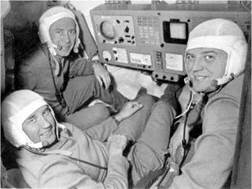A salute to Gagarin
In contrast, the Soviet program was not going well. All their effort for manned operations was now diverted to creating a space station. The objectives of this program were, typically, not forthcoming from the secretive Soviets, and would not be for some years. However, it was subsequently revealed by Soviet space watchers that there would be two distinctly separate space station programs, either civilian and scientific in nature or more military in intent, which would both be run under one heading, called “Salyut” to help mask the clandestine nature of the military stations.
In April 1971, as part of the celebrations for the 10th anniversary of the Gagarin flight, the first Salyut was launched. Tragically, the first man in space had not lived to see the tribute, having been killed in a plane crash in March 1968 at the age of 34. He had never had the opportunity to return to orbit. The first Salyut was a compromise between the DOS scientific stations (identified later as “civilian” in the West) planned by OKB-1 and the Almaz (“Diamond”) military – focused stations designed by OKB-52. It was plagued by difficulties from the start. The first crew (Soyuz 10), launched a few days after the Salyut, could not complete a hard docking and returned after only two days in space. Then the second crew was grounded when one of them failed a medical, so their intended mission was flown by the backup crew. Launched as Soyuz 11, this replacement crew completed a challenging 21 days on board the station but tragically died during the recovery phase due to a faulty air equalization valve.
As a result, the Soviet manned program was grounded and a planned third visit to the Salyut canceled. It would be two years before the next Soyuz crew entered orbit to test the improvements to the ferry craft and three years before a
|
The ill-fated Soyuz cosmonauts (left to right): Dobrovolsky, Patsayev, and Volkov. |
cosmonaut crew would enter another Salyut in orbit. During this period, the Americans completed both the Apollo program and the three Skylab program manned missions, forging ahead in both lunar and space station experiences much to the chagrin of the Soviets.
The final Apollo missions to the Moon were flown in 1972. Apollo 16 and 17 completed the J-series of scientific missions to more geologically challenging sites, maximizing the variety of samples retrieved from the six landing sites. The Apollo program was a highly successful series and, even with the Apollo 13 aborted landing, significant experience and confidence was gained in sending crews out to the Moon and from performing the first EVAs on the surface of another celestial body. Unfortunately, a number of factors contributed to the closure of the program, which prevented the Americans from expanding upon this experience and contributed to the diversion of hardware, funds, and investment elsewhere. Most notably, this was to the planned Space Shuttle program, which had been authorized in January 1972 and approved in April that year while the Apollo 16 astronauts were exploring the Moon.
Just over a decade after manned space flight had become possible, the emphasis was already changing. No longer was it a race to achieve leadership at the Moon. Now, a concerted effort to look back at Earth began to develop and with it, hopefully, the creation of economical access to and from Earth orbit, with additional emphasis on sustained and extended operations in low Earth orbit. When Apollo stopped flying to the Moon in December 1972, no one really thought it would be over 35 years before we would even consider going back there seriously with a new program, and probably over 50 years before we finally make it.











